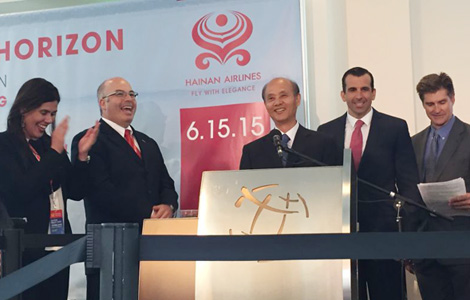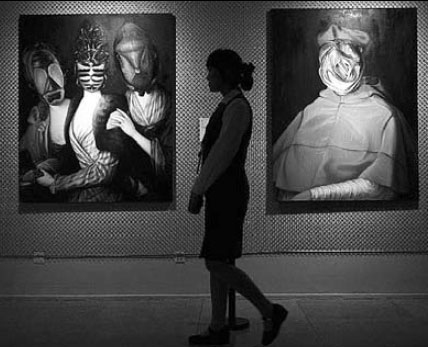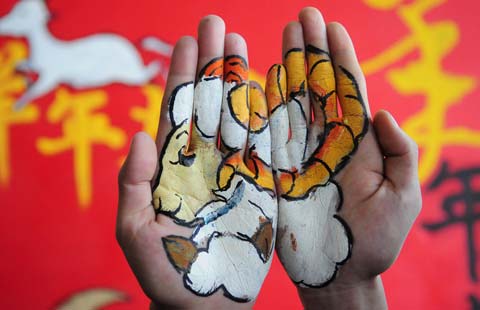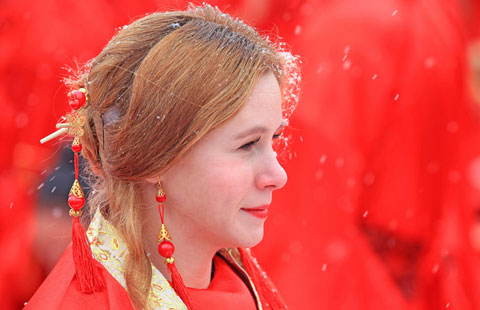Polish modern art shows social changes over time
Updated: 2015-06-16 07:11
By Lin Qi(China Daily)
|
||||||||
Treasures from Chopin's Country, the exhibition that concluded at National Museum of China a month ago, took visitors on a journey through five centuries of Polish fine arts. Now, Poland's modern art is being displayed for Chinese audiences at another venue in a show titled State of Life.
The latest exhibition, at the National Art Museum of China, has some 70 contemporary art pieces touching on Poland's social realities and culture, as well as the lives and emotions of its ordinary people. It mostly centers on the art landscape before and after 1989, when Soviet-led communism ended in Poland, and seeks to reveal how Polish artists noted changes in their nation's cultural identity and values over time.
In Wlodzimierz Pawlak's oil painting of 1986, Nostalgy, he uses the Polish national flag as the background. He paints a swimmer - a symbol of Polish people - struggling alone at the border of the white and red blocks, as if trying to stay above the surface of water. In it, the man sees no hope of being saved - the social emotions that Pawlak detected at the time.
|
The show State of Life at the National Art Museum of China touches on Poland's social realities and culture. Xinhua |
In the work, he expresses people's nostalgia for the passion that once dominated the Polish nation.
The mood dramatically transforms in Tadeusz Rolke's photo series, Tomorrow Will Be Better, taken in 1992.
It documents not only the beginning of Poland's transition in the early 1990s, but also the restart of people's lives in an era when new and old rules began to coexist.
Through Rolke's lens of calmness one can see people acting in varied ways toward the transformation. Some are profiting from their first barrels of gold - they converted beds into merchandise stands and public buses into restaurants - while the elderly are seen looking surprised and unprepared for the changes.
The Polish artists take more microcosmic perspectives after entering the 21st century. Their works focus on people's daily experiences and show how Polish art begins to integrate with globalization.
In his installation 2010 National Budget, Jan Simon materializes a bar chart for Poland's financial budget, by erecting rectangular bars of varied dimensions. He transforms the abstract concept of "public finance" into the language of avant-garde art.
Simon studied sociology and psychology at college. He likes to source inspiration from the concepts of the Internet and data banks. He often treads on the decline of civilization, among other subjects.
Nicolas Grospierre observes a different economic phenomenon in his photography project, Not Economically Viable, that spanned 2003 to 2005. Chinese visitors easily empathize as they see these incomplete and abandoned buildings in Grospierre's photos. Such real estate leftovers have become common in Poland since the 1990s. In China, they are referred to as lan wei lou.
The broken windows and unkempt look of the buildings can make people uncomfortable, as each unfinished or abandoned structure appears to tell the story of some failure.

Jaroslaw Suchan, director of Muzeum Sztuki in Lodz, says the exhibition is above all a discussion on modernization. "The works introduce Polish people's lifestyle today. Meanwhile they criticize the architecture and ways of life that people need to think over."
Suchan adds he is as such rather interested in the incisive expressions of Chinese contemporary artists to criticize social issues.
Muzeum Sztuki in Poland, among the world's oldest places of modern art, helped organize the Beijing exhibition and has loaned displays from its own collections.
"Contemporary art is something that is reborn after fighting supremacy, and discovers ways for different nationalities and cultures to coexist in contradiction," says Zhang Qing, deputy director of NAMOC.
"The works on show only provide us a tiny section of booming, vibrant Polish culture, between the forces of contemporary art and globalization."
linqi@chinadaily.com.cn
(China Daily 06/16/2015 page20)

 Ten photos you don't wanna miss - June 16
Ten photos you don't wanna miss - June 16
 Shaolin monks harvest bumper crop
Shaolin monks harvest bumper crop
 Cambridge students mark end of exam with boat race
Cambridge students mark end of exam with boat race
 Village attracts tourists after first lady's visit
Village attracts tourists after first lady's visit
 Top 9 US-listed Chinese companies going private
Top 9 US-listed Chinese companies going private
 Hainan San Jose to Beijing: Ready for take-off
Hainan San Jose to Beijing: Ready for take-off
 Trending Across China: A Porsche gilded in gold
Trending Across China: A Porsche gilded in gold
 Paris Air Show: From Bombardier's new C Series to China Airlines
Paris Air Show: From Bombardier's new C Series to China Airlines
Most Viewed
Editor's Picks

|

|

|

|

|

|
Today's Top News
Key China-US talks next week
Jeb Bush announces bid for 2016 Republican presidential run
Alibaba set for video-streaming launch
China, US develop new MERS treatment
China to complete land reclamation of construction on some Nansha Islands soon
Military launches drive to root out corruption in construction projects
China, US sign agreement to boost army cooperation
City honors slain NYPD
Detective Liu
US Weekly

|

|








